|
|
|
Sort Order |
|
|
|
Items / Page
|
|
|
|
|
|
|
| Srl | Item |
| 1 |
ID:
136060


|
|
|
|
|
| Summary/Abstract |
Like many other developing countries, South Asian nations have been experiencing increased foreign direct investment inflows over the past decade as developing countries get a larger share of cross-border investments that were once sent to developed countries. Nonetheless, South Asia’s inflows of foreign direct investment remain the lowest relative to gross domestic product among developing country regions. Why are South Asia’s foreign direct investment inflows so low and what lessons can be drawn for developing countries as a whole? The analysis in this article uses a novel empirical model that accounts for possible trends in convergence in the ratio of foreign direct investment to gross domestic product between countries and cross-sectional data for 78 countries from 2000 to 2011. The sample contains 52 developing countries. The analysis finds that two key factors are at work—high overall regulatory restrictions on foreign direct investment and specific restrictions placed on doing business with other countries. These factors include overall trade restrictiveness, which reduces the benefits to cross-border investments, and weak institutions to protect foreign investors and facilitate investment. Nonetheless, the potential for faster growth in intra- and inter-regional foreign direct investment flows is significant. The main factors leading to this conclusion are South Asia’s current low levels of foreign direct investment, the many unexploited opportunities for embodied knowledge transfer, and supply-chain linkages. The overall lessons for developing countries are that liberalizing policy constraints in both trade and foreign investment, keeping corporate tax rates modest, and improving governance and transparency could help to substantially improve foreign direct investment flows.
|
|
|
|
|
|
|
|
|
|
|
|
|
|
|
|
| 2 |
ID:
186522


|
|
|
|
|
| Summary/Abstract |
Due to the pro-independence demands of part of its electorate, the political fit of Catalonia within Spain has given rise to notable political tensions over the last few years. This conflict has progressively affected several dimensions of Catalan society, including, potentially, the economy. The illegal referendum on independence, held in October 2017, marked the climax of political and social tensions, leading to a Constitutional crisis and further stoking the conflict as opposed to offering any hope of an early resolution. We analyze a complete set of margins potentially affected by the referendum, including real (aggregate demand and supply) and financial responses. Using a synthetic control method, we find strong evidence of the outflow of short-term bank deposits after the referendum; while, on the real side, we find evidence of responses in aggregate supply (number of capital increases and number of new firms registered).
|
|
|
|
|
|
|
|
|
|
|
|
|
|
|
|
| 3 |
ID:
073554
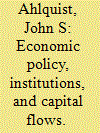

|
|
|
|
|
| Publication |
2006.
|
| Summary/Abstract |
Scholars examining the cross-national mobility of capital have followed two distinct paths. Economists tend to focus on the determinants and economic effects of cross-country capital movements while political scientists largely concentrate on the political impact of capital mobility. This study fills an important gap in the literature by examining the effects of economic policy outcomes on capital inflows to developing countries, explicitly comparing the reactions of portfolio and direct investors. I find that portfolio investors are in fact sensitive to past government behavior and fiscal policy outcomes; portfolio investors reallocate funds as new information about government policy becomes available. Direct investors, on the other hand, are not sensitive to macrolevel economic policy outcomes but are concerned with political institutions. Countries with more stable and democratic political institutions attract more FDI. These findings have implications for developing country governments as they consider the sequence of market liberalizing reforms.
|
|
|
|
|
|
|
|
|
|
|
|
|
|
|
|
| 4 |
ID:
152760


|
|
|
|
|
| Summary/Abstract |
This article examines the effects of capital flows on economic growth in Senegal using autoregressive distributed lag (ARDL) over the period 1970–2014. Overall, our results show that remittances cause economic growth in Senegal in the long run. In contrast, external debt has a negative impact on economic growth. The ARDL results, however, show no cointegration between aid and growth or between foreign direct investment (FDI) and growth. The Quandt–Andrews breakpoint test selects year 1991 as the most likely breakpoint location for the remittances–growth equation. Finally, time-varying parameter analyses using the year 1991 as a slope dummy reveal that remittances have been growth-enhancing post-1991. Therefore, government and policy makers in Senegal must create a favourable atmosphere for attracting more remittances to promote economic development.
|
|
|
|
|
|
|
|
|
|
|
|
|
|
|
|
| 5 |
ID:
172213
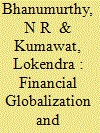

|
|
|
|
|
| Summary/Abstract |
The article examines relationship between financial globalization and economic growth in South Asian countries namely Bhutan, Bangladesh, India, Maldives, Nepal, Pakistan and Sri Lanka. Following the framework of Bekaert et al. (2005) and with the help of Panel VAR and Panel causality (in GMM framework) models the study concludes that the causation from financial globalization to growth in the region appears to be weak. There appears reverse causation running from growth to financial globalization. We found that domestic macroeconomic policies such as fiscal prudence act as pull factors for foreign capital. The article has some interesting results at individual country level.
|
|
|
|
|
|
|
|
|
|
|
|
|
|
|
|
| 6 |
ID:
138043
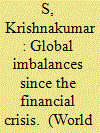

|
|
|
|
|
| Summary/Abstract |
This paper undertakes an appraisal of the origins of global imbalances since the late 1990s, examines the link to the global financial crisis and the consequences of the untavelling of the existing financial system on emergin market economies.
|
|
|
|
|
|
|
|
|
|
|
|
|
|
|
|
| 7 |
ID:
172369


|
|
|
|
|
| Summary/Abstract |
This study presents an empirical analysis of the impact of the US unconventional monetary policy and its normalization on the dynamics of relatively volatile capital inflows (i.e., portfolio equity, portfolio debt securities, and bank and money market) into the Philippines using monthly data from January 2008 to March 2016. Results are obtained using a structural vector autoregression (SVAR) model, interacting both “push” and “pull” factors of capital inflows into the SVAR system. Overall, results show that the effects of these US monetary policy shocks on the aforementioned volatile capital inflows are minimal when scaled in terms of gross domestic product (GDP). The findings also suggest that, of the three volatile capital inflows, the impact of these shocks is more pronounced on portfolio debt securities, as well as on bank and money market inflows. Meanwhile, the impact on portfolio equity inflows is very limited. Additionally, the persistence of these shocks is seen to last from one to six months.
|
|
|
|
|
|
|
|
|
|
|
|
|
|
|
|
| 8 |
ID:
106399
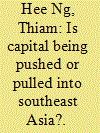

|
|
|
|
|
| Publication |
2011.
|
| Summary/Abstract |
The paper aims to examine if push or pull factors are driving capital inflows into Southeast Asia. Using factor analysis, we find that there is one common factor that is driving capital flows into the region. This common factor, which can be interpreted as a push factor, accounts for 35 per cent of the variance of capital inflows into the region. Regression analysis shows that the push factor is strongly influenced by investors' risk perception and, to a lesser extent, by business cycle in the United States. This is worrying as risk perception can change quickly during periods of crisis and the capital inflows could suddenly turn into outflows, as seen during the recent global financial crisis.
|
|
|
|
|
|
|
|
|
|
|
|
|
|
|
|
| 9 |
ID:
147432
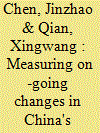

|
|
|
|
|
| Summary/Abstract |
Liberalizing China's capital account controls may have profound implications for the RMB exchange rate, monetary policy autonomy, and Chinese economy. However, rigorous studies on the importance of China's capital controls are limited, primarily due to the scarcity of proper measurements of China's capital controls. In this paper we create a new data set of indices including de jure and hybrid measurements of the changes in China's capital controls. In contrast to other capital control indices that are compiled in a yes-or-no style, we quantify the intensity of changes in China's capital controls. Our indices reveal a persistent but uneven process of capital account liberalization in China between 1999 and 2012. This paper describes the de jure and hybrid indices, including indices for capital controls on individual asset categories, gross flows, inflows and outflows, as well as for resident and nonresident asset transactions. Understanding that China usually implements policies in a step by step gradualist style, we extract this gradual information from the text in the IMF's Annual Report on Exchange Arrangement and Exchange Restrictions (AREAER) and some supplementary material from other sources.
|
|
|
|
|
|
|
|
|
|
|
|
|
|
|
|
| 10 |
ID:
106390
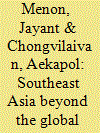

|
|
|
|
|
| Publication |
2011.
|
| Summary/Abstract |
The special issue of the ASEAN Economic Bulletin examines a number of policy issues relating to capital flows into Southeast Asia in the aftermath of the global financial crisis. The contributions to this volume address both thematic issues and country studies, examining a wide range of emerging issues relating to the influx of capital flows to the region. The findings and their policy implications offer insights into managing the impacts of crises in general and surges in capital flows in particular, as well as issues relating to post-crisis macroeconomic policy, currency realignment, and regional cooperation.
|
|
|
|
|
|
|
|
|
|
|
|
|
|
|
|
| 11 |
ID:
161848
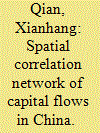

|
|
|
|
|
| Summary/Abstract |
Using data from China's High-Value Payment System, this paper directly and precisely measures interregional capital flows in China and analyzes their spatial correlation. Using social network analysis methods, this study finds a spatial correlation network between interregional capital flows. The closeness of the network is strong and has a high stability. Different provinces exhibit different positions in the network. Beijing, Jiangsu, Shandong, Shanghai, and Zhejiang are at the relative core, while Qinghai, Xinjiang, Guangxi, Anhui, and Tibet are at the periphery. According to a block model, the eastern provinces belong to a bidirectional spillover block, the middle provinces are in a primary beneficial block, and the western provinces are in a net beneficial block. Based on a quadratic assignment procedure regression analysis, the paper concludes that geographical distance and differences in provinces' fixed asset investments, foreign direct investments, and marketization levels are important factors that impact the spatial correlation of capital flows. The conclusions of this paper are significant for the formulation of a regional coordinated strategy in China.
|
|
|
|
|
|
|
|
|
|
|
|
|
|
|
|
| 12 |
ID:
147334


|
|
|
|
|
| Summary/Abstract |
The article analyses the behaviour of net total capital inflow and its components since the introduction of liberalisation in India in 1991. An introspective analysis of capital flow reveals that capital inflow in India is volatile in nature and it is volatile in exactly the wrong direction, in a sense that it is pro-cyclical rather than countercyclical. However, all types of flows should not be treated equally. Being the most volatile and least persistent components, FPI and commercial bank inflow should be monitored very cautiously. The volatility of foreign direct investment (FDI) and commercial borrowing has gradually increased, although it has declined recently. External assistance has declined steadily and lost its dominance relative to the other counterparts. There is ample evidence of complementarity among the components of capital flows though we get a glimpse of substitutability between FDI and FPI—the two most voluminous components of capital flows. Contrary to a-cyclical, non-debt creating flows, commercial borrowings and commercial bank flows are found to be pro-cyclical in nature. The net total capital inflow series contain three structural breakpoints, at 1995Q4, 2002Q4 and 2006Q2. Domestic growth performance, policy changes and external shocks are the key factors behind these obtained structural breaks. There was a noticeable change in the behaviour of total capital flow and its components over the four phases identified in the article.
|
|
|
|
|
|
|
|
|
|
|
|
|
|
|
|
|
|
|
|
|